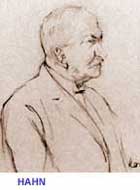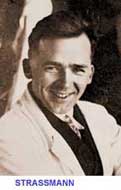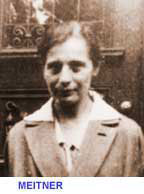Most physicists ignored that sort of wild journalism. All they wanted was to get a better picture of the nucleus. One big step came in 1932, when Cockcroft and Walton, in Rutherford's laboratory, built a machine that could shoot a beam of protons at very high speeds. They fired protons, like bullets, into metal targets. The collisions transformed some of the nuclei in the target atoms. Some of the atoms' mass was converted into energy. The Cockcroft-Walton experiment demonstrated for the first time a concept that Albert Einstein had proposed almost thirty years earlier. He had theorized that energy and mass are equivalent; they can be converted into one another. Let's hear Einstein tell about it...
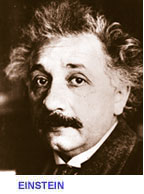 EINSTEIN: It followed from the special theory of relativity that mass and energy are
both but different manifestations of the same thing—a somewhat unfamiliar
conception for the average mind. Furthermore, the equation E is equal
to mc2, in which energy is put equal to mass, multiplied
with the square of the velocity of light, showed that very small amounts
of mass may be converted into a very large amount of energy and vice versa.
The mass and energy were in fact equivalent, according to the formula mentioned
before. This was demonstrated by Cockcroft and Walton in 1932, experimentally.
EINSTEIN: It followed from the special theory of relativity that mass and energy are
both but different manifestations of the same thing—a somewhat unfamiliar
conception for the average mind. Furthermore, the equation E is equal
to mc2, in which energy is put equal to mass, multiplied
with the square of the velocity of light, showed that very small amounts
of mass may be converted into a very large amount of energy and vice versa.
The mass and energy were in fact equivalent, according to the formula mentioned
before. This was demonstrated by Cockcroft and Walton in 1932, experimentally.
The New York Times reacted to experiments like those by Cockcroft and Walton with enthusiasm...
NEWS ARTICLE: "Science has obtained conclusive proof from recent experiments that the innermost citadel of matter, the nucleus of the atom, can be smashed, yielding tremendous amounts of energy and probably vast new stores of gold, radium and other valuable minerals."
But the Cockcroft-Walton work—and every other nuclear physics experiment during the thirties—used up far more energy than it released. So physicists doubted that nuclear energy could be put to practical use anytime soon, if ever. Rutherford made this opinion public in 1933 at a scientific meeting, and his remarks were published in the scientific journal Nature:
NEWS ARTICLE: "These transformations of the atom are of extraordinary interest to scientists but we cannot control atomic energy to an extent which would be of any value commercially, and I believe we are not likely ever to be able to do so... Our interest in the matter is purely scientific, and the experiments which are being carried out will help us to a better understanding of the structure of matter."
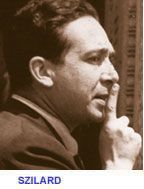 A few physicists were not so sure that nuclear energy could never be controlled.
Leo Szilard thought of a possible way to do it. If he could find some sort
of nucleus that would emit two neutrons whenever it was bombarded
with one neutron, he might be able to set off a chain reaction. Szilard
wanted to investigate various elements, including uranium. But he was not
able to get money to do experiments.
A few physicists were not so sure that nuclear energy could never be controlled.
Leo Szilard thought of a possible way to do it. If he could find some sort
of nucleus that would emit two neutrons whenever it was bombarded
with one neutron, he might be able to set off a chain reaction. Szilard
wanted to investigate various elements, including uranium. But he was not
able to get money to do experiments.
It was only in 1938 that many scientists began to focus their attention on uranium, the heaviest of known elements. Leading the pack were two German chemists, Otto Hahn and Fritz Strassmann. For over thirty years, Hahn had been working with another talented scientist, Lise Meitner. However, Meitner was of Jewish ancestry, and had to flee Nazi Germany. Otto Hahn recalls...
HAHN: Miss Meitner—Professor Meitner—had left our laboratory on July 1938 on account of these Hitler regime things and she had to go to Sweden. And Strassmann and myself, we had to work alone again and in the autumn of '38 we found strange results.
